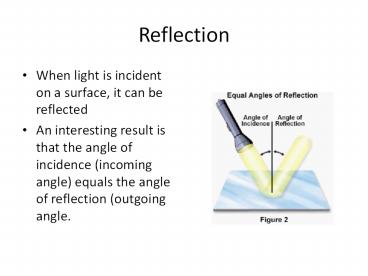Reflection - PowerPoint PPT Presentation
Title:
Reflection
Description:
Reflection When light is incident on a surface, it can be reflected An interesting result is that the angle of incidence (incoming angle) equals the angle of ... – PowerPoint PPT presentation
Number of Views:232
Avg rating:3.0/5.0
Title: Reflection
1
Reflection
- When light is incident on a surface, it can be
reflected - An interesting result is that the angle of
incidence (incoming angle) equals the angle of
reflection (outgoing angle.
2
Reflection from a curved surface
- When the surface doing the reflecting is curved,
the light can be brought to a focus. - The curved surface can be parabolic or spherical.
- Spherical surfaces are cheaper and easier to
construct.
3
Power towers
- Use many collectors and focus the light to a
central point. - Achieves high temperatures and high power
density. - Each individual collector is called a heliostat
- Must be able to track the sun and focus light on
the main tower
4
How they work
- Light is collected at the central tower, which is
about 300 feet tall. There are on the order of
2000 heliostats. - Used to heat water and generate steam
- Steam drives a turbine which generates
electricity - Often include auxiliary energy storage to
continue to produce electricity in the absence of
sunlight - More costly to construct and operate than coal
fired plants. - Good candidates for cogeneration-waste steam
could be used for space heating
5
Solar troughs
- A parabolic shaped trough collects the light and
focuses it onto a receiver. - The receiver has a fluid running through it which
carries the heat to a central location where it
drives a steam turbine - May have more than a hundred separate troughs at
such a facility
6
Trough Pictures
7
Direct Conversion of sunlight to
energyPhoto-voltaics
- Photoelectric effect
- When electromagnetic energy impinges upon a
metal surface, electrons are emitted from the
surface. - Hertz is often credited with
- first noticing it (because he
- published his findings) in 1887
- but it was seen by Becquerel
- In 1839 and Smith in 1873.
8
Photoelectric effect
- The effect was a puzzle
- The theory of light as a wave did not explain the
photoelectric effect - Great example of the scientific method in action.
- Up until this point, all the observations of
light were consistent with the hypothesis that
light was a wave. - Now there were new observations could not be
explained by this hypothesis - The challenge became how to refine the existing
theory of light as a wave to account for the
photoelectric effect
9
Photoelectric effect explained
- Einstein in 1905 explained the photoelectric
effect by assuming light was made of discrete
packets of energy, called photons. - Not a new idea, he was building upon an idea
proposed by Planck, that light came in discrete
packets. (in fact, Newton proposed a particle
like explanation of light centuries earlier).
The problem for Planck was his discrete packets
were in conflict with the wave like behavior of
light.
10
Photoelectric effect explained
- But now, a behavior of light was observed that
fit Plancks energy packet idea. - So electromagnetic radiation appears to behave as
if it is both a wave and a particle. - In fact, you can think of light as discrete wave
packets-packets of waves which, depending upon
the measurement you make, sometimes exhibit
particle behavior and sometimes exhibit wave
behavior. - Einstein won the Nobel prize for his explanation
of the photoelectric effect.
11
Semi conductors
- Devices which have conductive properties in
between a conductor and an insulator. - Normally, the outer (valence) electrons are
tightly bound to the nucleus and cannot move. - If one or all of them could be freed up, then the
material can conduct electricity - Silicon is an example of a semi-conductor.
12
Silicon
- Element 14 in the periodic table
- Very common element (sand, glass composed of it)
- 8th most common element in the universe
- Its 4 outer valence electrons are normal tightly
bound in the crystal structure. - However, when exposed to light, the outer
electrons can break free via the photoelectric
effect and conduct electricity. - For silicon, the maximum wavelength to produce
the photoelectric effect is 1.12 microns. 77 of
sunlight is at wavelengths lower than this.































